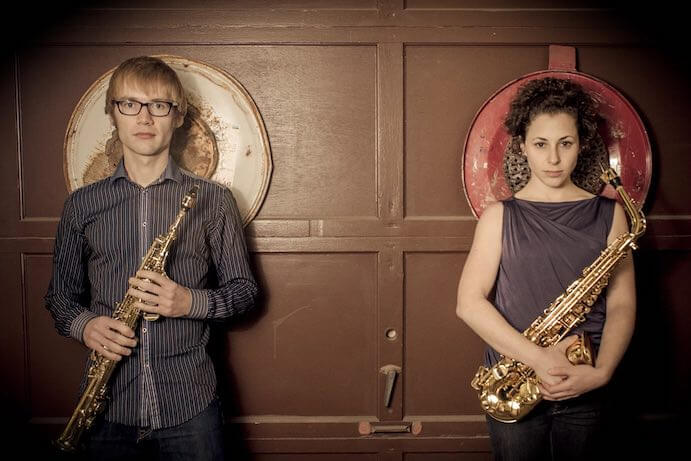The saxophone is an instrument of the future. Invented much later than the violin, flute, and other instruments, the sax enjoys a refreshing lack of historical baggage, save for certain jazz associations. Noa Even and Phil Pierick of the Cleveland-based saxophone duo Ogni Suono take full advantage of this inherent newness, extending the expressive potential of the saxophone beyond any identifiable confines and exploring the continuum between the instrument and human voice. Released September 7, 2018 onNew Focus Recordings, SaxoVoce is Ogni Suono’s second full-length record, presenting a formidable array of new commissions by Kate Soper, Zach Sheets, Chris Fisher-Lochhead, David Reminick, Felipe Lara, Christopher Dietz, and Erin Rogers.
Opening with a muted soundscape of multiphonics and broadening quickly into brash, feedback-heavy tones, Kate Soper’s OTOTOI establishes the outer extremes of the saxophone’s timbral range with remarkable succinctness. Inspired by Aeschylus’ Agamemnon, OTOTOI depicts the torments of Kassandra, cursed to see future events believed by no one. Even and Pierick capture this sense of growing desperation with a well-controlled, gradual crescendo of increasingly-ornamented saxophone utterances, rising to a fever pitch before retreating suddenly into a somber mist.

Kate Soper–Photo by Marco Giugliarelli
Zach Sheets’ dare-gale, speaks and spells is the virtuosic high point of the album, running the gamut of extended techniques for both saxophone and voice. Breathy whirs give way to percussive tongue clicks; later in the piece, whistles, hums, and singing mix in intricate choreography. Sheets’ writing gives the impression of a single, sinewy organism, as both instruments interact in tightly-wound arpeggiations and canonic imitations. By contrast, Chris Fisher-Lochhead’s Chroma features two saxophones moving in similar, yet independent paths. Although both instruments engage in the same musical vocabulary of microtones, fluttering tremolos, and faint vocalizations, they trace unhurried circles around each other, colliding like drifting space objects. An intriguing juxtaposition of placid textures with dissonant harmonies, Chroma is SaxoVoce’s most magical and otherworldly moment.
Perhaps the most “traditional” work on SaxoVoce, David Reminick’s two-movement suite Walking After Midnight is nevertheless engaging, evocative, and musically demanding—Reminick asks both musicians to “sing throughout the piece…classical vocal training is not required.” Even and Pierick take on this double-duty task with impressive dedication, alternating quickly between energetically syncopated saxophone playing and highly angular vocal passages. The text poignantly illustrates a parent reacting to their four-year-old’s sleepwalking episode, supplemented wonderfully by musical word-painting: for example, “his tiny snores in time to the lunar tides of his chest” is followed by a peaceful, lopsided rhythm, trailing away into silence.
Like an epic tone-poem, Felipe Lara’s Vocalise II moves with gravitas, its formless beginning building slowly into an F-sharp drone, over which capricious melodic contours swirl. These melodies are more fragmented and oblique than bel canto; vehement inhales and punctuating tongue clicks give the overriding effect of effort, as if the performers are laboring to construct consonant intervals above the drone.

Ogni Suono–Photo by Aaron Long
Ogni Suono particularly shines in works containing sociopolitical overtones. In My Manifesto and Me, Christopher Dietz quotes a rhetoric-laden scene from the war movie Full Metal Jacket. At the piece’s outset, Even and Pierick recite a quasi-Pledge-of-Allegiance mantra before blaring through a declamatory saxophone passage. Glassy-eyed phrases like “Without me my manifesto is useless—without my manifesto I am useless” and “No alternatives and no opposition, only compliance” parody the human tendency towards oversimplification, while the ad nauseum repetition of the word “peace” is coupled with a frenetic crescendo suggesting anything but. My Manifesto and Me is saved from a completely literal reading by contrasting moments of soft, hesitating low tones, suggesting a more reflective, critical voice in the melee.
Likewise, Erin Rogers‘ Clamor contains a sobering message beneath its veneer of humorous stream-of-consciousness vocalizations. A concentrated outburst of surreal phrases and exhilarating noise-heavy saxophone techniques, Clamor’s textual gems include “one, two, three, four, five, six, B-FLAT,” “not sure why he drank three cups of milk,” and “I love avocado toast,” to name a few. Towards the end of the piece, however, Even unleashes a stream of word battery in which phrases like “over-easy embryos,” “congressional pork sausage,” “global warming hot cake,” and “farm-to-table legislation” are audible. The use of politically charged words casts a different light on the mayhem—becoming a depiction of present-day political and capitalistic excesses. Roger’s Clamor is a perfect album closer, showcasing the sheer breadth of exploration Ogni Suono is capable of.
SaxoVoce is a tour de force of new possibilities for saxophone and voice, providing a blueprint for the creation of future saxophone duo repertoire. The album’s featured works contain enough formal and stylistic variety to sustain close listening engagement throughout; furthermore, Even and Pierick’s playing highlights a veritable encyclopedia of sound-production techniques spanning the saxophone/voice spectrum. With SaxoVoce, Ogni Suono insists on the saxophone’s versatility, its expressive power and unique voice—suggesting that the sax does not simply belong within the distinguished pantheon of “classical” instruments, but rather may exist somewhere further beyond.




















